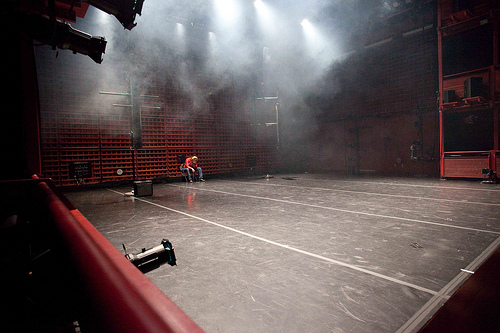American Longing and James Dean in Last Meadow
BY Thom Donovan
 This past weekend I had the chance to check out Miguel Gutierrez and The Powerful People’s production Last Meadow, a dance-performance work that is part of the American Realness Festival happening throughout January in New York City. Gutierrez’s work first came to my attention a couple years back when we performed together in a cabaret at my former pad on Avenue A in Manhattan. What Gutierrez did in the cabaret was engaging—an acoustic version of Taylor Dayne’s “Tell It To My Heart”—but what particularly impressed me about Gutierrez was his ability to discuss dance so articulately in terms of cultural politics.
This past weekend I had the chance to check out Miguel Gutierrez and The Powerful People’s production Last Meadow, a dance-performance work that is part of the American Realness Festival happening throughout January in New York City. Gutierrez’s work first came to my attention a couple years back when we performed together in a cabaret at my former pad on Avenue A in Manhattan. What Gutierrez did in the cabaret was engaging—an acoustic version of Taylor Dayne’s “Tell It To My Heart”—but what particularly impressed me about Gutierrez was his ability to discuss dance so articulately in terms of cultural politics.
Last Meadow is unique for the ways that it approaches cultural politics through a variety of performance techniques including, but not exclusive to, dance/movement research. At the center of the performance is James Dean, who the dancers impersonate, deconstruct, and ultimately cathect both as a figure for queer culture and as an icon of post-war America. Throughout the performance of Last Meadow, I was thinking about longing and grieving in terms of Dean’s place in U.S. cultural mythology. Other than Brando, Dean is of course the male actor of the 50s, representing an American cultural tendency to place feelings over ideas, actions over verbiage, psychology above philosophy. In the three films Dean made, he is both insider and outsider, hero and rebel, naïf and sage. Though I hadn’t realized it before seeing Last Meadow, Dean is also a melancholic figure in all of the three films he made (Rebel Without a Cause, East of Eden, and Giant); all of his characters have a Melvillian air about them—adventurous but dejected.
Last Meadow is a kind of elegy/eulogy for America (both its idea and reality) which, in a monologue, Gutierrez himself refers to as a “disaster” (Gutierrez dances in his works, as well as being the choreographer). At another moment the dancer Terek Hallaby—who cross-dresses as Judy from Rebel Without a Cause—sings the (United States) national anthem through a reverb-effected Fender amp placed on the stage. Hallaby’s voice resembles that of Angelo Badalamenti’s singers—the ones he used for David Lynch’s films and the Twin Peaks television program: it is pure; perhaps too pure. Hallaby doesn’t sing the anthem for very long. Just long enough to give the audience goosebumps.
But the real mourning of Last Meadow (if a work of mourning is what it's doing) has to do with Gutierrez’s use of cinematic techniques in live, movement-based performance. One of the opening vignettes of Last Meadow (the performance has the rhythm of consecutive vignettes or episodes) has Gutierrez, Michelle Boullé, and Hallaby onstage together as Jim, Judy, and Plato from Rebel Without a Cause. The dancers don’t say anything aloud, but their gestures mimic exactly those of Rebel Without a Cause’s original actors (Dean as Jim, Nathalie Wood as Judy, and Sal Mineo as Plato). It is as if the sound track has been removed. This disjuncture of sound and image-track is a powerful move on Gutierrez and co’s part. Had Last Meadow done nothing else but lip-synch in this way throughout the entire production I would have been satisfied by the performance.
The word that kept runnning through my head throughout Last Meadow was “cinematicalness.” There is a feeling for the cinema, and almost everything about Last Meadow evokes this feeling. Another extraordinary technique that Gutierrez used was an interlocution between himself and the other two dancers in which he would say their lines with/over them, timing this “voice over” precisely. Reciting a scene from Elia Kazan’s East of Eden in which Dean (as Cal) is about to leave his house and Julie Harris (as Abra) adjusts his tie, the scene is first played between Hallaby (as Harris playing Abra) and Boullé (as Dean playing Cal). It is played again with Gutierrez saying their lines over them in the Fender amp, and for a third time with Boullé absented from the scene, looking at herself in the mirror as Dean playing Cal.
While there was so much else to like (and report about) in Last Meadow this scene was among my favorites for its minimalism and the powerful impact it exerted through simple means. I think the scene’s impact has something to do with repetition (witnessing a scene repeatedly, as though a film or video loop); but also with the disjuncture of image/voice, script/actor, sound-track/image-track. It also has to do with bringing cinema onto the stage—redoubling the cinematic image through the image of actors/dancers. Is uncanny the word I’m looking for here? There is certainly a recognition that something we thought to be itself is not what or where we thought it should be (Freud’s definition of the uncanny). In Last Meadow’s lip-synch of Dean films some of the most sentimental and nostalgic images we have of the American imaginary are not merely deconstructed (though they are slowed down, and broken down, and explained to us a la Brecht) but not where they should be inasmuch as they are being reproduced too accurately in a different medium.
Thom Donovan lives in New York City where he edits Wild Horses of Fire weblog (whof.blogspot.com) and...
Read Full Biography

